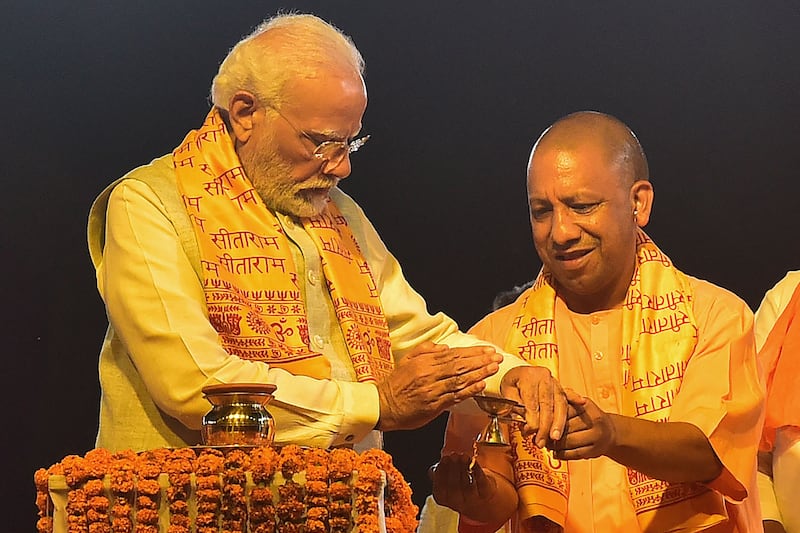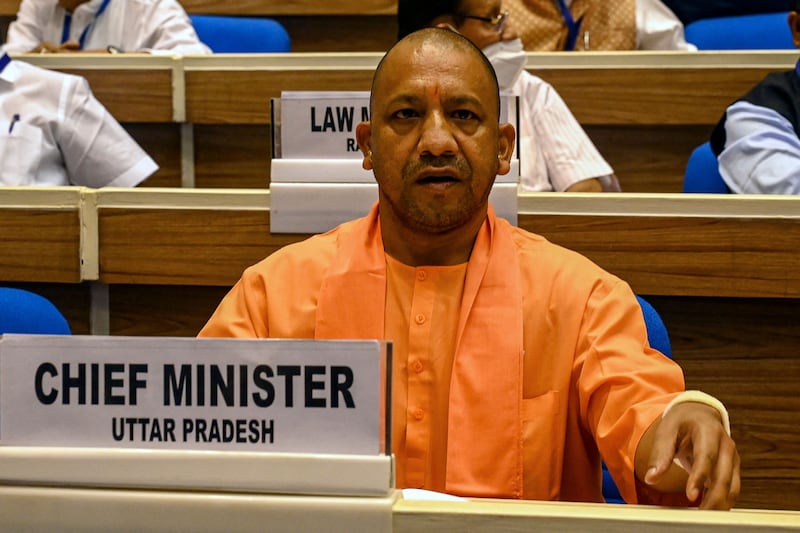When the police in India’s largest state put a notorious mobster-politician’s associates in their sights, they unleashed a take-no-prisoners campaign that at times mirrored the brutality of their underworld targets, who had been implicated in a brazen murder.
In three separate raids, officers in the state of Uttar Pradesh shot dead four of those associates, including the mobster-politician’s son. The deadly “encounters”, as such apparent extrajudicial killings are called in India, won praise from the state’s leader, Yogi Adityanath, a hardline Hindu monk who is seen as a potential prime minister.
[ Report and video: Former politician shot on live televisionOpens in new window ]
Members of Adityanath’s Hindu nationalist governing party and loyal broadcast media outlets echoed the praise, but also posed a prodding question: Why had the mobster-politician himself, Atiq Ahmed, who was already serving a life sentence and had 100 other cases pending against him, been spared a similarly abrupt and bloody end?
That came on Saturday night.
RM Block
Ahmed, along with his brother, was fatally shot at close range on live television as the two were being taken by the police to the hospital for what had been described as a routine check-up.
The three assailants – one of whom extended his arm in front of an officer’s face to fire the bullet as the gun touched Ahmed’s head – rained several rounds of bullets into the two men and continued firing after they had crumpled to the ground, before officers in a 17-person security cordon stepped in to tackle them. As they were taken away, the attackers repeatedly shouted “Jai Shri Ram” – hail to the Hindu lord Ram. Afterwards, two state ministers described the murders of the two Muslim mobsters as akin to divine justice.
The exceptionally public spasm of violence has once again raised alarm about how deeply extrajudicial violence has seeped into the state’s governance, a campaign that often carries religious undertones as the governing Bharatiya Janata Party moves to reshape India’s secular democracy.
Uttar Pradesh, with 240 million residents, makes up one-sixth of India’s population, and events there have broad ramifications for the rest of the country.
The concept of the rule of law gets redefined as a form of coercive power that is arbitrary, partisan and violent. These violent practices are then turned into slogans and electoral props
— Gilles Verniers, professor of political science at Ashoka University
Analysts and rights activists are troubled by many aspects of the situation: an overwhelmed and ineffective judiciary; the public’s desensitisation to – or even embrace of – violence; and a broadcast media that enables this desensitisation by abetting the demonisation of the Hindu-first government’s perceived adversaries.
But what is most troubling is that politicians are learning that violence can yield political dividends in a country deeply polarised along religious lines. In this atmosphere, small-time criminals become heroes of the increasingly militarised Hindu right wing, and leaders such as Adityanath, perpetually dressed in the saffron robe of a monk, find themselves in demand as a protector of Hindu interests.
“The government isn’t interested in trusting its own judiciary or judicial process,” said Gilles Verniers, a professor of political science at Ashoka University who has studied Uttar Pradesh politics closely. “It aims to substitute itself to it, recasting the coercive function of the state as an instrument of strongman’s governance. The concept of the rule of law gets redefined as a form of coercive power that is arbitrary, partisan and violent. These violent practices are then turned into slogans and electoral props.”

Verniers said Adityanath had built a reputation as a strongman by publicly endorsing and promoting extrajudicial action. According to police officials, more than 180 people have died in “encounters” with the police since Adityanath took over as chief minister in 2017. He has also sent bulldozers to raze the homes of activists or protesters, endorsed vigilante action against people accused of smuggling cows or having interfaith relationships and quieted dissenting voices with questionable charges under harsh laws.
“From the beginning of his political career, he has projected himself as a monk-soldier, a vigilante unencumbered by due process or the rule of law. His accession to power in 2017 enabled him to put the state at the service of his violent inclinations,” Verniers said. “There is no doubt that this has earned him more supporters than detractors.”
The Uttar Pradesh government’s media office did not answer a question about the increase in extrajudicial violence. In a statement, the state government confirmed that it had formed a commission of inquiry, headed by a retired justice, to look into the murders and submit its report in two months.
Vijay Mishra, Ahmed’s lawyer, said his client had approached India’s Supreme Court two weeks before his murder asking for protection, as he feared he was about to be killed. The court told him that the state would protect him.
“Knowing the risk involved, the police should have taken extra care when it comes to taking him to the hospital from jail. It was their responsibility, and the blame lies on them. The failure to protect his life lies at them,” Mishra said. “When these men fired, the police was so scared that they did not fire back. I want to ask, why do they keep their guns, then? Do they keep these weapons only for scaring the common man?”

Ahmed’s notorious career had won him many enemies. Although his straddling of politics and crime was not unique in Uttar Pradesh or India, his record appears particularly gruesome.
Over four decades firming his grip over a neighbourhood of Prayagraj city, formerly known as Allahabad, he amassed more than 100 pending court cases against him, as his lawyer confirmed. Charges included kidnapping, murder and extortion.
What gave Ahmed protection was that he turned his criminal reach into political leverage: As his gang struck fear, he managed to win elections five times as a local assembly member and once as a member of parliament, using his political influence – as well as the patronage of the parties previously in power in Uttar Pradesh that courted Muslim votes – to stay ahead of the law.
That became harder after Ahmed got to parliament in 2004. To keep Ahmed’s old local assembly seat within the family, his brother ran for the office – and lost a close race to a man named Raju Pal. Soon after, Pal was killed, with Pal’s family pointing blame at Ahmed.
As the murder case wound on, Ahmed’s political fortunes waned. He lost his parliament seat and early this year was convicted of kidnapping the main witness in Pal’s murder case and pressuring him to change his testimony.
Then, in February, that witness, Umesh Pal, was shot dead, along with his two police guards. The state promised a firm crackdown; the “encounters” targeting Ahmed’s son and associates soon followed.
“These mafias will be reduced to dust,” Adityanath declared in the Uttar Pradesh state assembly after the killing of Umesh Pal.
Asim Ali, a researcher and political scientist in New Delhi, said violence in Uttar Pradesh increasingly appeared to be “according to political benefit,” even as surveys showed a perception among the state’s residents that law and order had improved.
Ali said that under the banner of a crackdown on mafia and thuggery that had long menaced the state, Adityanath appeared to be waging a selective campaign: targeting criminals who proved a problem for his support base, while protecting and empowering others who came from his caste and stronghold. Opposition politicians in Uttar Pradesh have levelled similar accusations against Adityanath.
Ali said selective treatment of crime in the state was not new; leaders before Adityanath had used such tactics. But one thing was different.
“What’s changed now is a judiciary which has stopped challenging the government on issues they deem to be of core interests to the ruling party,” he said. “Yogi will go as far as he can do without losing his post. And that depends on how weak he perceives the justice system to be.”
– This article originally appeared in The New York Times.




















